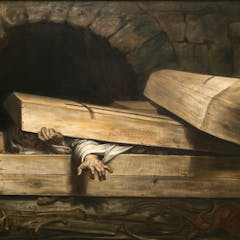
Articles on Vampires
Displaying 1 - 20 of 28 articles

Monsters reveal how societies define and punish deviance. Wintering’s widows make me think about the women I know who are strong and wise in ways neither recognised nor endorsed by the mainstream.

Renfield attempts to remodel the vampire movie to 21st century specifications.

Black vampires have existed for 200 years in literature.

A newsletter sends out chronological snippets from the 125-year-old novel ‘Dracula.’ Fans on the internet go wild.

Everyone is going ‘goblin mode’, but does the trend unfairly malign goblins of folklore?

Many of Count Orlok’s characteristics have gone on to be canon in the lore of vampires.

The past century’s vampires have often been a bit dashing, even romantic. That’s not how the myth started out.

These medical volunteers have been closely associated with several kinds of non-human actors, whose behaviour is worth examining in more detail.

A tale of vampirism would have been shocking to readers at the time if was published, not because of its monsters, but its politics.

The latest version of the Gothic vampire chiller is brought to you with the trademark humour of writers Steven Moffat and Mark Gatiss.

Vampire bats form social bonds similar to human friendships – and they’re good friends to those in need.

Fear of a disease that seemed to turn people into beasts might have inspired belief in supernatural beings that live on in today’s creepy Halloween costumes.

Written in the same house party as Mary Shelley’s Frankenstein, Polidori’s creature was based on the “mad, bad and dangerous to know” Lord Byron.

One of the reasons the myth of vampires endures and captures the popular imagination is that vampires are a powerful metaphor for a wide range of cultural practices and social problems.

A Mr Darcy Halloween costume anyone? How the brooding hero of Pride and Prejudice has been reinvented as a vampire.

The story of how Mary Shelley dreamed up Frankenstein is famous. Less well-known, however, is the reading material that inspired her to write.

From naked mole rats to the immortal jellyfish – the creatures that would make Dracula shudder.

New research is uncovering medieval legends about the undead in Britain.

Gothic fiction has become the ideal genre for exploring the grotesque, frightening aspects of coming of age. And disruptive girls with supernatural powers have replaced the passive heroines of old.

Based on the 2004 novel, Let the Right One is a bloody staging of a vampire romance. Except in this show, the predator is a teenage girl.
